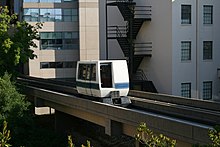| Personnel Rapid Transit | |
|---|---|
 | |
| Overview | |
| Locale | Durham, NC, US |
| Transit type | People mover |
| Number of stations | 3 |
| Operation | |
| Began operation | 1979-12-08 |
| Ended operation | 2009 |
| Operator(s) | Duke University |
| Number of vehicles | 3 |
| Technical | |
| Track gauge | concrete guideway |
Duke University Medical Center Patient Rapid Transit or Personnel Rapid Transit (PRT) was an automated people mover system located at the Duke University Medical Center in North Carolina, in the United States.[1] The system was in operation from 1979 to 2009.[2] The PRT was notable for having cars propelled by a linear induction motor and suspended on a bed of compressed air[3] similar to a hovercraft. Uniquely, the cars could move sideways, as well as backwards and forwards.[3]
The proclaimed "horizontal elevator" system was designed by Otis Elevator Company during the 1970s, installed beginning in 1977 and opened on December 8, 1979. The PRT had three driverless Otis Hovair vehicles[4] which had a hinged-window at each end for emergency exit.[5]
The concrete guideway was built as double track, connecting the three stations at Duke South, Duke North and Parking Garage II via a tunnel under Erwin Road.[6]
- ^ "PRT Supervisor, Senior". Duke University Job Description. Duke University Human Resources. 2007-12-01. Archived from the original on 2007-06-09. Retrieved 2009-10-17.
... Personnel Rapid Transit system utilized to transport patients, employees, visitors and supplies between Duke Hospital North, Duke Hospital South and Parking Garage II.
- ^ Cite error: The named reference
scramswas invoked but never defined (see the help page). - ^ a b Wessner, Laura (December 1978). "Air-cusion people mover". Popular Science. Vol. 213, no. 6. Bonnier Corporation. p. 64. ISSN 0161-7370.
three 22-passenger ... no rotating parts ... a linear-induction motor propels the cars ... ice, rain and snow don't limit performance ... the cars can move sideways
- ^ Richards, Brian (2001). Horizontal elevators and peoplemovers. Taylor & Francis. p. 130. ISBN 978-0-415-26142-5. Retrieved 2009-10-17.
developed by Otis ... their first vehicle was called Hovair
{{cite book}}:|work=ignored (help) - ^ Peacock, Richard D. (Jan 1979). "Fire Safety Guidelines for Vehicles in a Downtown People Mover System". Final Report National Bureau of Standards (NBSIR 78-1586). Washington: Center for Fire Research, National Engineering Laboratory, National Bureau of Standards. Bibcode:1979nbs..reptQ....P.
- ^ "Clinic Parking Information". Pediatric Urologic Care. Duke University Division of Urology. Retrieved 2009-10-17.
a walkway and monorail beneath Erwin Road from the garage to Duke Hospital